 | –≠–ª–µ–∫—Ç—Ä–æ–Ω–Ω—ã–π –∫–æ–º–ø–æ–Ω–µ–Ω—Ç: LA2650 | –°–∫–∞—á–∞—Ç—å:  PDF PDF  ZIP ZIP |
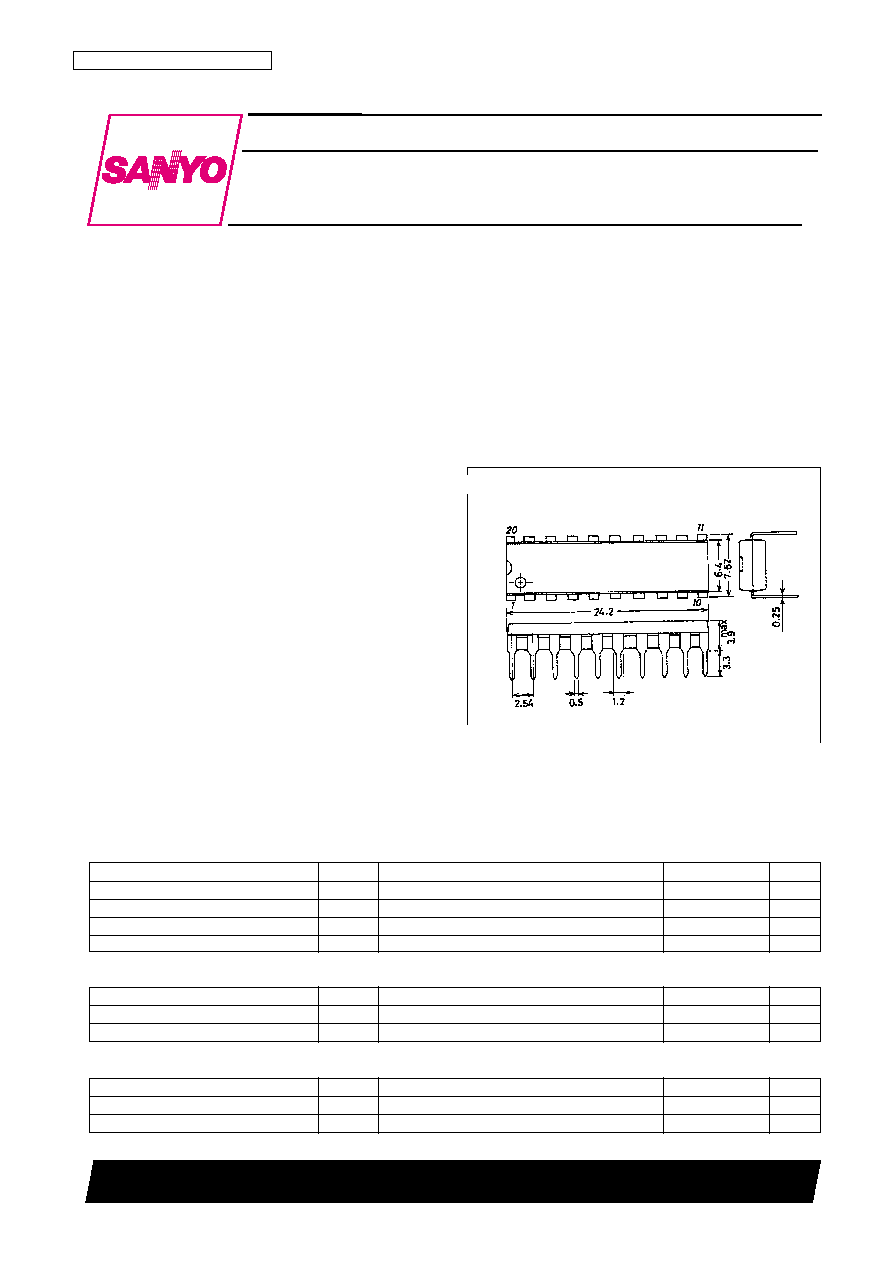
Ordering number : EN5652
43097HA(OT) No. 5652-1/13
Overview
The LA2650 is a bass boost IC developed for use in mini-
component stereo systems, TV sets, and radio/cassette
player products. The cutoff frequency is determined by
external capacitors, and the boost gain, addition level, and
boost on/off state can be controlled by a microcontroller.
Features
∑ The bass boost gain is variable over a maximum range
of 20 to 35 dB in 5-dB steps, and the addition level into
the left and right channels can be controlled over a 0 to
≠35 dB range in 3-dB and 5-dB steps. This allows an
optimal boost for the source and volume to be acquired
using microprocessor control.
∑ Includes two AGC circuits on chip: a level limiter (2 V
rms) for the maximum input in low-frequency boost
mode and a non-clipping limiter (i.e. clip prevention)
circuit.
∑ Can be switched between 2D and 3D systems.
Functions
∑ Variable boost gain (20, 25, 30, and 35 dB)
∑ Boost level limiter, non-clipping limiter
∑ Variable boost addition level (0, ≠3, ≠6, ≠9, ≠15, ≠20,
≠25, and ≠35 dB)
∑ Left and right channel boost addition on/off
∑ Bass output pin for use in 3D systems
∑ Boost on/off
∑ LED on/off
∑ 8-bit serial microprocessor interface
Package Dimension
unit: mm
3021B-DIP20
SANYO: DIP20
[LA2650]
LA2650
SANYO Electric Co.,Ltd. Semiconductor Bussiness Headquarters
TOKYO OFFICE Tokyo Bldg., 1-10, 1 Chome, Ueno, Taito-ku, TOKYO, 110 JAPAN
Bass Boost IC
Monolithic Linear IC
Parameter
Symbol
Conditions
Ratings
Unit
Maximum supply voltage
V
CC
max
12
V
Allowable power dissipation
Pd max
Ta
70∞C
450
mW
Operating temperature
Topr
≠25 to +70
∞C
Storage temperature
Tstg
≠40 to +150
∞C
Specifications
Maximum Ratings
at Ta = 25∞C
Parameter
Symbol
Conditions
Ratings
Unit
Recommended supply voltage
V
CC
9
V
Operating voltage range
V
CC
op
5 to 10
V
Operating Conditions
at Ta = 25∞C
Parameter
Symbol
Conditions
Ratings
Unit
Low-level voltage
V
IL
0 to 1.5
V
High-level voltage
V
IH
3.5 to
*
5.5
V
Control Data Input Voltage Levels
Note: When V
CC
is under 5.7 V, the maximum value shall be V
CC
≠ 0.2 V.
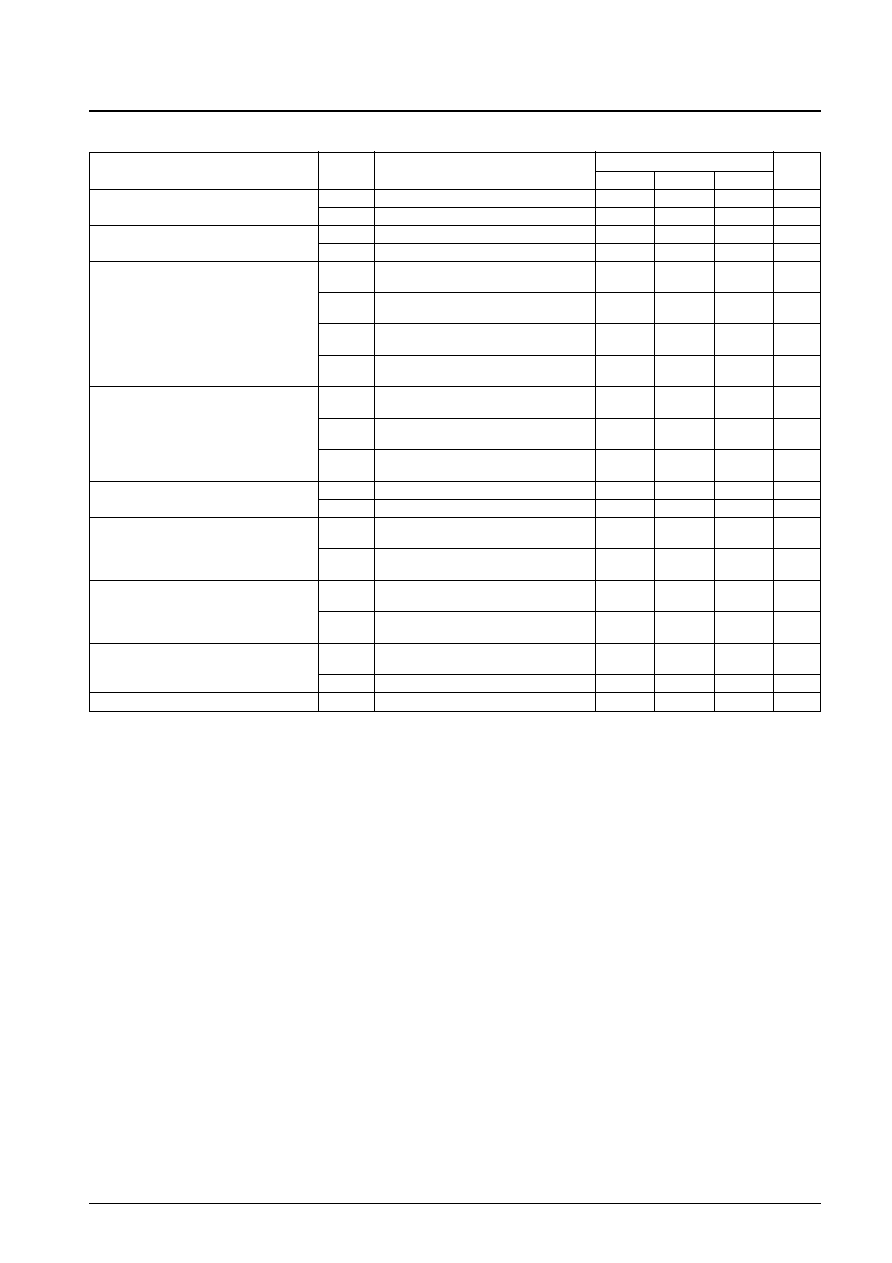
No. 5652-2/13
LA2650
Parameter
Symbol
Conditions
Ratings
Unit
min
typ
max
Quiescent current
I
CCO
T
Boost: off
5
8
13
mA
I
CCO
B
Boost: on
6
9
14
mA
Voltage gain
VGT
V
IN
= 0 dBm, Boost: off
≠2
0
+2
dB
VGB
V
IN
= 0 dBm, Boost: on
≠2
0
+2
dB
BST1
Boost: on, f
i
= 50 Hz, BST = 35 dB,
25.5
28.5
31.5
dB
ADD = 0 dB, V
IN
= ≠30 dBm
BST2
Boost: on, f
i
= 50 Hz, BST = 35 dB,
21
24
27
dB
Boost level: high
ADD = 0 dB, V
IN
= ≠20 dBm
BST3
Boost: on, f
i
= 50 Hz, BST = 35 dB,
13
15
17
dB
ADD = 0 dB, V
IN
= ≠10 dBm
BST4
Boost: on, f
i
= 50 Hz, BST = 35 dB,
5
7
9
dB
ADD = 0 dB, V
IN
= 0 dBm
BST1
Boost: on, f
i
= 50 Hz, BST = 30 dB,
15
18
21
dB
ADD = ≠6 dB, V
IN
= ≠20 dBm
Boost level: low
BST2
Boost: on, f
i
= 50 Hz, BST = 30 dB,
8
10
12
dB
ADD = ≠6 dB, V
IN
= ≠10 dBm
BST3
Boost: on, f
i
= 50 Hz, BST = 30 dB,
1.5
3.5
5.5
dB
ADD = ≠6 dB, V
IN
= 0 dBm
Maximum output voltage
V
O
maxT
THD = 1%, Boost: off
2.00
2.55
V
V
O
maxB
THD = 1%, Boost: on
2.00
2.55
V
THD T
V
IN
= ≠10 dBm, Boost: off,
0.008
0.03
%
Total harmonic distortion
BPF = 400 Hz to 30 kHz
THD B
V
IN
= ≠10 dBm, Boost: on, f
i
= 50 Hz,
0.3
0.9
%
LPF = 30 kHz
CT T
V
O
= 0 dB, Rg = 10 k
, DIN AUDIO,
80
88
dB
Crosstalk
Boost: off
CT B
V
O
= 0 dB, Rg = 10 k
, DIN AUDIO,
50
59
dB
Boost: on
V
NO
T
Rg = 10 k
, JIS A, Boost: off,
≠97
≠90
dBm
Output noise voltage
Boost ADD = off
V
NO
B
Rg = 10 k
, JIS A, Boost: on
≠91
≠84
dBm
LED current
I
LED
RED LED
11
15
19
mA
Electrical Characteristics
at Ta = 25∞C, V
CC
= 9 V, f
i
= 1 kHz, R
L
= 10 k
, BST = 35 dB, ADD = 0 dB, BST:ADD = ON

No. 5652-3/13
LA2650
Control Data
for the Parameters in the Electrical Characteristics
*
=don't care
Parameter
Conditions
D1
D2
D3
D4
D5
D6
D7
D8
Quiescent current
I
CCO
T Boost: on
L
L
L
L
L
L
L
L
I
CCO
B Boost: off
H
H
H
H
H
H
L
H
Voltage gain
V
IN
= 0 dBm
VG T Boost: off
L
L
L
L
L
L
L
L
VG B Boost: on
H
H
H
H
H
H
L
H
Boost level: high
Boost: on, f
i
= 50 Hz, BST = 35 dB, ADD = 0 dB
H
H
H
H
H
H
L
H
Boost level: low
Boost: on, f
i
= 50 Hz, BST = 30 dB, ADD = ≠6 dB
H
L
H
L
H
H
L
H
Maximum output voltage
THD = 1%
V
O
maxT Boost: off
L
L
L
L
L
L
L
L
V
O
maxB Boost: on
H
H
H
H
H
H
L
H
Total harmonic distortion
V
IN
= ≠10 dBm
THD T Boost: off, BPF = 400 Hz to 30 kHz
L
L
L
L
L
L
L
L
THD B Boost: on, f
i
= 50 Hz, LPF = 30 kHz
H
H
H
H
H
H
L
H
Crosstalk
V
O
= 0 dBm, Rg = 10 k
, DIN AUDIO
CT T Boost: off
L
L
L
L
L
L
L
L
CT B Boost: on
H
H
H
H
H
H
L
H
Output noise voltage
Rg = 10 k
, JIS A
V
NO
T Boost: off, Boost ADD = off
L
L
L
L
L
L
L
L
V
NO
B Boost: on
H
H
H
H
H
H
L
H
LED current
I
LED
RED LED
*
*
*
*
*
*
H
*
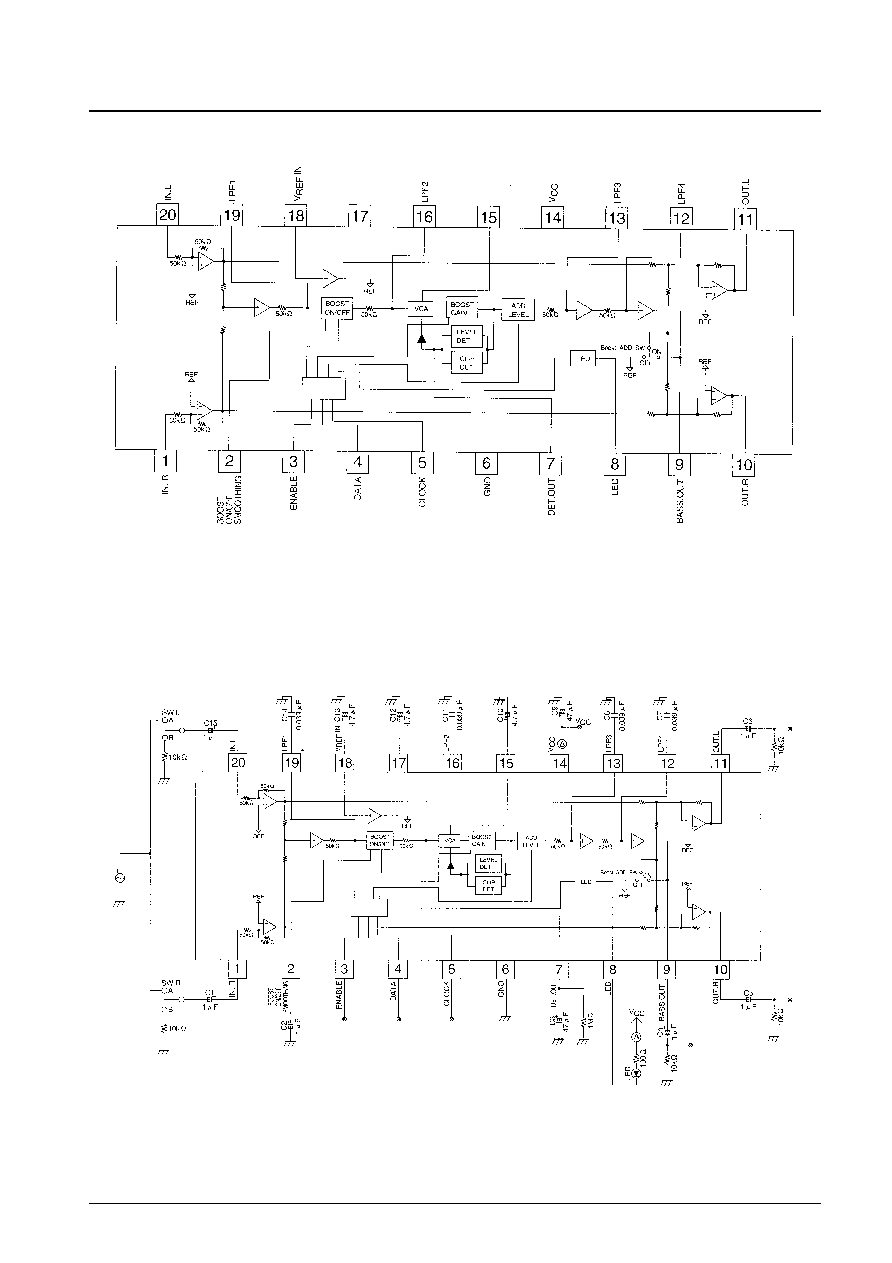
DC-CUT
VCA NF
5 to 10 V
Block Diagram
No. 5652-4/13
LA2650
VCA NF
DC-CUT
DECODER
DECODER
Test Circuit
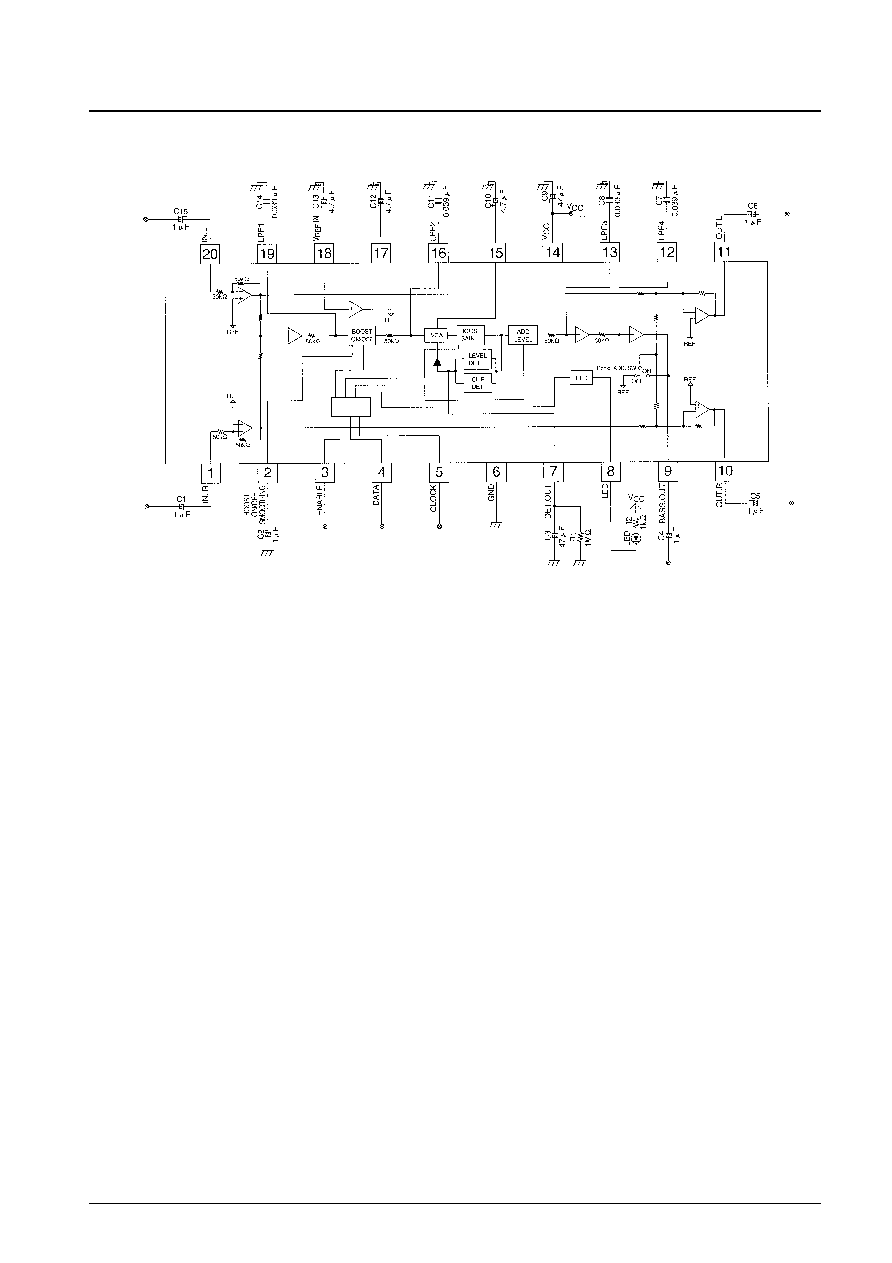
Sample Application Circuit
No. 5652-5/13
LA2650
DC-CUT
VCA NF
5 to 10 V
DECODER
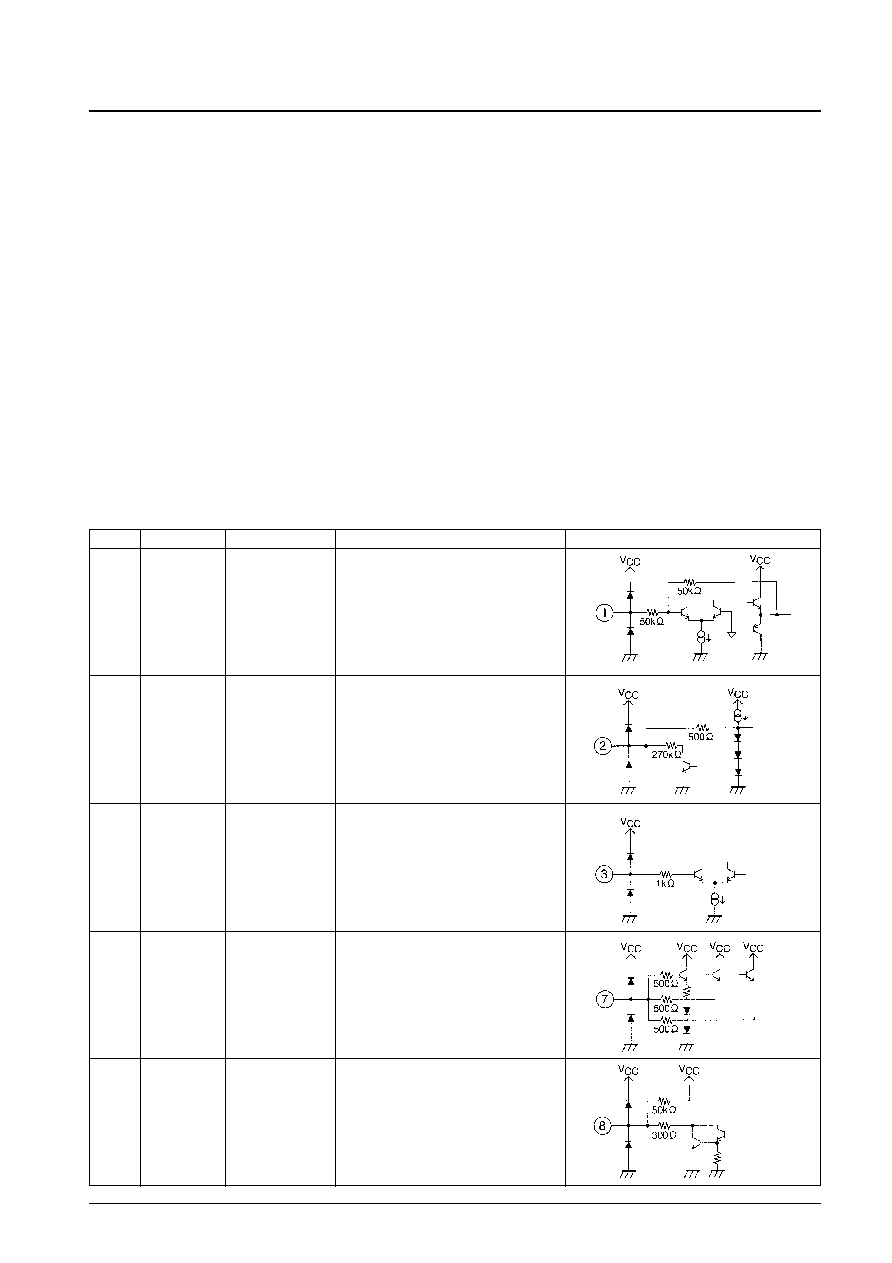
Notes on LA2650 Operation
LPF cutoff frequency
Use the following formula to calculate the cutoff frequency:
∑ fc = 1/(2
CR) Hz
However: R = 50 k
, since the resistor is on chip.
Thus the cutoff frequency can be set by the external capacitor.
Example: C = 0.039 µF (As in the sample application circuit)
fc = 81.6 Hz
Maximum boost gain
Use the following formula to calculate the maximum boost gain.
∑ BASS OUT total gain (G
B
) =
+4
◊
20 log
10
(1 + 4
2
f
2
C
2
R
2
)
≠1/2
+
Here,
= Boost gain (20, 25, 30, or 35 dB)
= Addition level (0, ≠3, ≠6, ≠9, ≠15, ≠20, ≠25, or ≠35 dB)
f: Frequency
C: The LPF external capacitor
R = 50 k
(built in)
Example: When
= 35 dB,
= 0 dB, f = 50 Hz, C = 0.039 µF (As in the application circuit)
G
B
= 29.46 dB
No. 5652-6/13
LA2650
Pin Functions
Pin No.
Pin
Pin voltage (V)
Pin function
Equivalent circuit
1
IN-L
1/2 V
CC
Signal input pin
20
IN-R
The input impedance is 50 k
2
BOOST
0.7 to 2
Smoothing pin for boost on/off switching
ON/OFF
SMOOTHING
3
ENABLE
Apply either 0 or 5 V.
Serial control data input pins
4
DATA
5
CLOCK
7
DET-OUT
1.7 to 3.5
The detection attack and recovery times are set
by the external resistor and capacitor connected
to this pin.
8
LED
V
CC
max.
LED cathode
Influx current: 20 mA (maximum)
Continued on next page.

No. 5652-7/13
LA2650
Pin No.
Pin
Pin voltage (V)
Pin function
Equivalent circuit
9
BASS-OUT
1/2 V
CC
Low boost output for 3D systems
10
OUT-R
1/2 V
CC
Signal outputs
11
OUT-L
12
LPF4
1/2 V
CC
LPF connection for the low-boost circuit
13
LPF3
Internal resistor: 50 k
19
LPF1
15
VCA NF
1/2 V
CC
VCA feedback
16
LPF2
1/2 V
CC
LPF connection for the low-boost circuit
Internal resistor: 50 k
17
DC-CUT
1/2 V
CC
Connection for DC-cut capacitor
18
V
REF
IN
1/2 V
CC
V
REF
amplifier reference
Continued from preceding page.
Note: Pin voltage values are typical values.

External Components
∑ C
1
, C
15
(0.22 to 10 µF)
Input coupling capacitor.
Note that the low-frequency gain is reduced at lower capacitances.
The value of these capacitors determines the extreme low-frequency cutoff.
∑ C
2
(0.22 to 2.2 µF)
Boost on/of switching circuit smoothing capacitor.
The on/off switching time can be adjusted by changing the value of this capacitor. However, note that if the value is
lowered excessively, switching noise (spikes) may appear.
∑ C
3
(10 to 220 µF)
Detection capacitor.
The attack and recover times can be adjusted by changing the value of this capacitor.
∑ C
4
, C
5
, C
6
(0.22 to 10 µF)
Output coupling capacitors.
∑ C
7
, C
8
, C
11
, C
14
Low boost LPF capacitors.
The low boost curve can be adjusted by changing the values of these capacitors. These capacitors may be omitted or,
inversely, secondary or tertiary structures may be used.
∑ C
9
(22 to 220 µF)
Power supply capacitor.
∑ C
10
(1.0 to 22 µF)
VCA NF capacitor.
Note that lowering the value of this capacitor will lower the low-frequency boost.
This capacitor determines the extreme low-frequency cutoff.
∑ C
12
(1.0 to 22 µF)
DC cut capacitor
Note that lowering the value of this capacitor will lower the low-frequency boost.
This capacitor determines the extreme low-frequency cutoff.
∑ C
13
(1.0 to 22 µF)
RF reference LPF capacitor.
The RF SVRR can be modified by changing the value of this capacitor.
∑ R
1
(200 k
to 3.9 M
)
Detection recovery time adjustment (discharge resistor)
Note that the total harmonic distortion is increased as the value of this resistor is reduced.
∑ R
2
(0 to 1 k
)
LED current adjustment.
LED current
(V
CC
≠ V
LED
≠ 0.9)/(R
2
+ 300)
The maximum LED current is 20 mA.
No. 5652-8/13
LA2650

Control Format
No. 5652-9/13
LA2650
Add Level Select
D1, D2, D3
Add level
Notes
H, H, H
0 dB
H, H, L
≠3 dB
H, L, H
≠6 dB
H, L, L
≠9 dB
L, H, H
≠15 dB
L, H, L
≠20 dB
L, L, H
≠25 dB
L, L, L
≠35 dB
Initial setting for the V
CC
on time
Boost Gain Select
D4, D5
Boost gain
Notes
H, H
35 dB
H, L
30 dB
L, H
25 dB
L, L
20 dB
Initial setting for the V
CC
on time
Left and right channel boost add on/off
L
H
D6
off
on
LED on/off
L
H
D7
off
on
Boost on/off
Mode Switching
∑ Add level select
-- Selects the addition level at the output mixing amplifier for the low-frequency signals from the boost amplifier.
∑ Boost gain select
-- Selects the amplification applied to low-frequency signals by the boost amplifier.
∑ Left and right channel boost add on/off
-- Turns addition of the low-frequency boosted signal to the left and right channels on or off.
∑ LED on/off
-- Turns the LED on or off.
∑ Boost on/off
-- Turns the amplification of low-frequency signals on or off.
L
H
D8
off
on
Note: The V
CC
on time and all other data is initialized to low.
Data
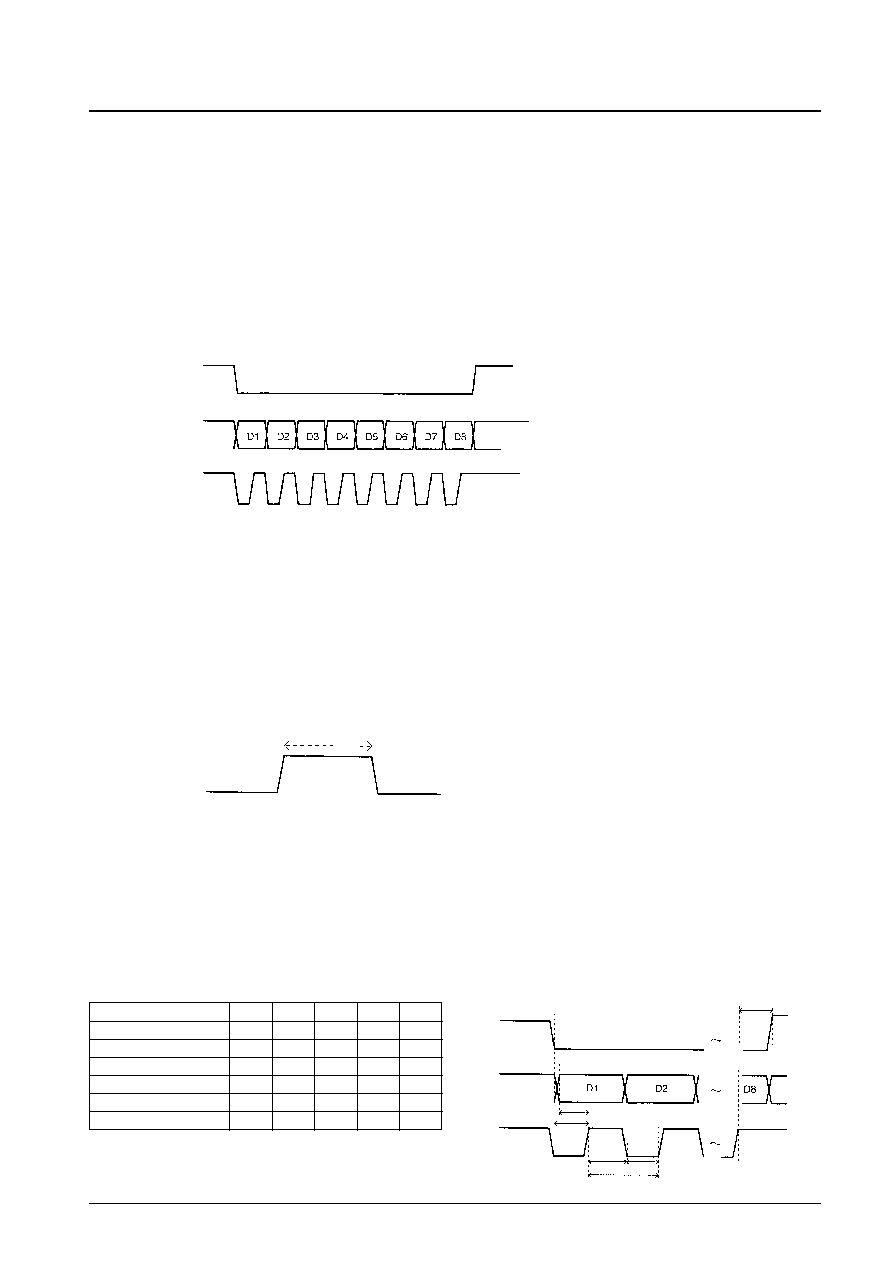
Recommended Data Transfer Procedure
The boost gain select and the left and right channel boost add on/off settings should only be set at power on. During
normal operation, control the device by setting the add level select and boost on/off settings. Using the add level select
and boost on/off settings for control is superior from the standpoint of minimizing switching noise (spikes).
Limiter (ALC) Operation
∑ The level limiter operates when the boost gain amplifier output level reaches about 2 V rms, and suppress further level
increases above that point.
∑ The non-clipping limiter operates to prevent boost gain amplifier output clipping at power-supply voltages (about 8.5 V
and lower) at which the output cannot be amplified to the operating level of the level limiter.
∑ Notes on Control Data
-- Data is read in on the rising edge of the clock signal.
-- Data consists of 8 bits, D1 through D8.
-- The input data is latched on the rising edge of the enable signal.
-- When the LA2650 is not being controlled, the clock and the enable signal must be held high.
-- Intervals between commands
The timing of the intervals on the enable signal must meet the conditions shown in the figure below.
∑ Initial Settings at Power on
-- All data is reset to low when power is first applied.
-- Applications should send their initial data settings once the IC is fully operational after power is applied, i.e. about
0.5 second after power is applied.
∑ Data Timing
No. 5652-10/13
LA2650
Timing characteristics
min
typ
max
unit
Enable clock delay time
t
ec
5
µs
Data clock delay time
t
dc
5
µs
Clock high-level hold time
t
ch
5
µs
Clock low-level hold time
t
cl
5
µs
Clock enable delay time
t
ce
5
µs
Clock cycle time
t
ck
10
µs
At least 10 µs
Enable
Enable
Enable
t
ce
t
ch
t
ec
t
dc
t
ck
t
cl
Data
Data
Clock
Clock
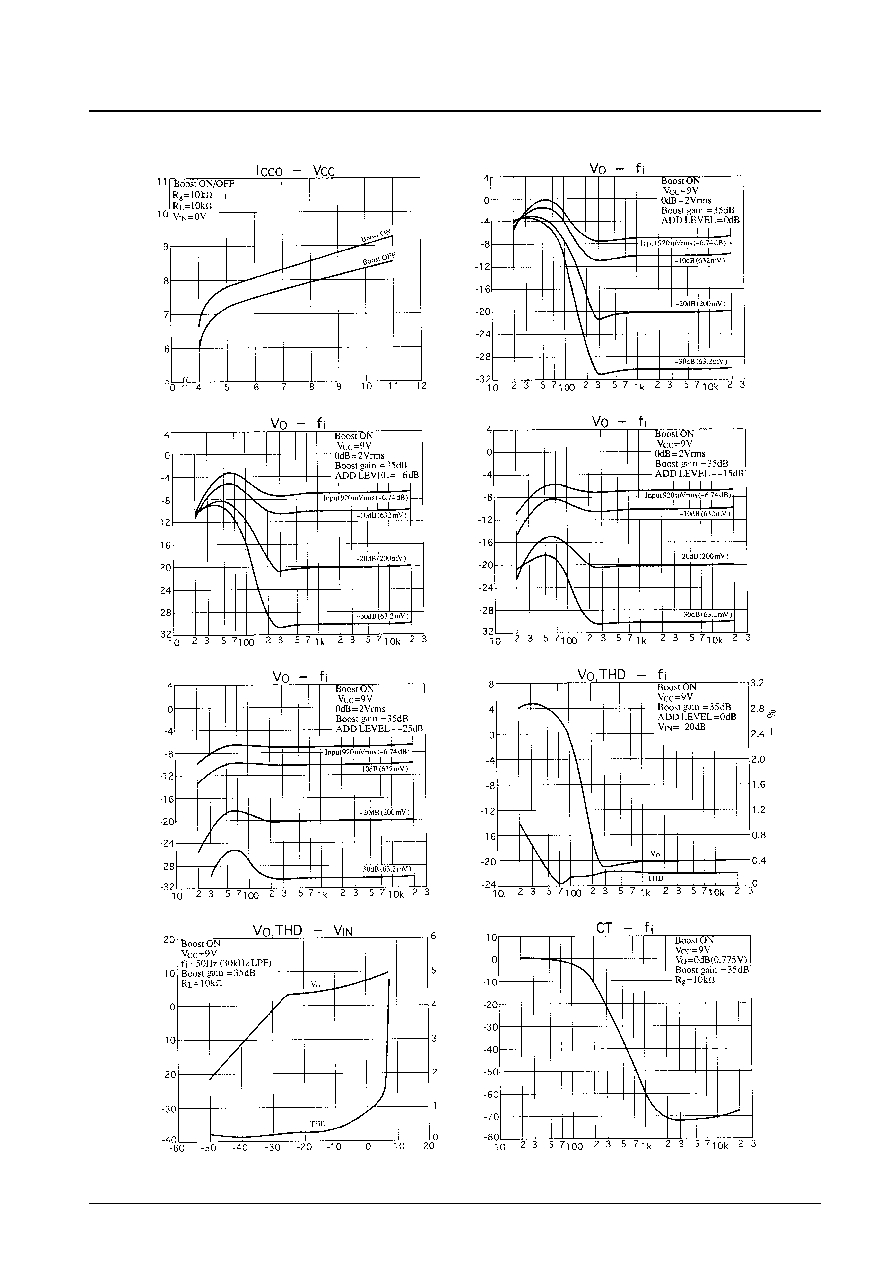
Total harmonic distortion, THD ≠ %
crosstalk, CT ≠ dB
No. 5652-11/13
LA2650
Quiescent current, I
CCO
≠ mA
Output voltage, V
O
≠ dB
Output voltage, V
O
≠ dB
Output voltage, V
O
≠ dB
Output voltage, V
O
≠ dB
Output voltage, V
O
≠ dB
Output voltage, V
O
≠ dB
Total harmonic distortion, THD ≠ %
Supply voltage, V
CC
, ≠ V
Input frequency, f
i
≠ Hz
Input frequency, f
i
≠ Hz
Input frequency, f
i
≠ Hz
Input voltage, V
IN
≠ dBm
Input frequency, f
i
≠ Hz
Input frequency, f
i
≠ Hz
Input frequency, f
i
≠ Hz
Filter: flat
Filter: 80 kHz LPF
L
R
R
L is identical.
I/O C = 1 µF

No. 5652-12/13
LA2650
Voltage gain, VG ≠ dB
Output noise voltage, V
NO
≠ dB
Output voltage, V
O
≠ dBm
Current drain, I
LED
≠ mA
Output noise voltage, V
NO
≠ dBm
Total harmonic distortion, THD ≠ %
Crosstalk, CT ≠ dB
Maximum output voltage, V
Omax
≠ V
Supply voltage, V
CC
≠ V
Supply voltage, V
CC
≠ V
Supply voltage, V
CC
≠ V
Supply voltage, V
CC
≠ V
Input frequency, f
i
≠ Hz
Input frequency, f
i
≠ Hz
Supply voltage, V
CC
≠ V
Input frequency, f
i
≠ Hz
Input C = 1 µF
Input C = 1 µF
I/O C = 1 µF
THD = 1%
I/O C = 1 µF
Rg = 10 k
R
L
= 10 k
I/O C = 1 µF
I/O C = 1 µF
Rg = 10 k
L
R
R
L is identical.
Total harmonic distortion, THD ≠ %
With no LED
series resistor
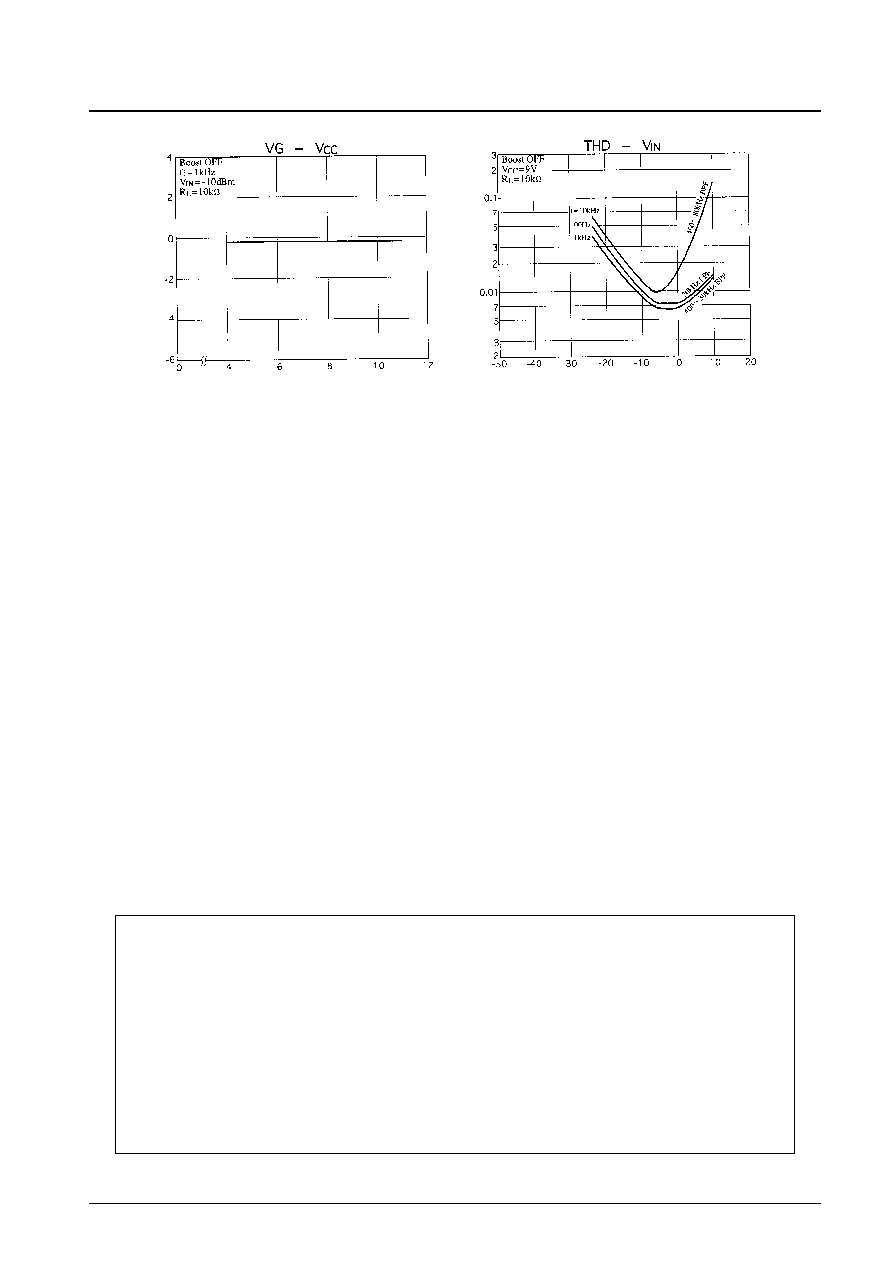
No. 5652-13/13
LA2650
This catalog provides information as of May, 1997. Specifications and information herein are subject to change
without notice.
s
No products described or contained herein are intended for use in surgical implants, life-support systems, aerospace
equipment, nuclear power control systems, vehicles, disaster/crime-prevention equipment and the like, the failure of
which may directly or indirectly cause injury, death or property loss.
s
Anyone purchasing any products described or contained herein for an above-mentioned use shall:
Accept full responsibility and indemnify and defend SANYO ELECTRIC CO., LTD., its affiliates, subsidiaries and
distributors and all their officers and employees, jointly and severally, against any and all claims and litigation and all
damages, cost and expenses associated with such use:
Not impose any responsibility for any fault or negligence which may be cited in any such claim or litigation on
SANYO ELECTRIC CO., LTD., its affiliates, subsidiaries and distributors or any of their officers and employees
jointly or severally.
s
Information (including circuit diagrams and circuit parameters) herein is for example only; it is not guaranteed for
volume production. SANYO believes information herein is accurate and reliable, but no guarantees are made or implied
regarding its use or any infringements of intellectual property rights or other rights of third parties.
Voltage gain, VG ≠ dB
Supply voltage, V
CC
≠ V
Total harmonic distortion, THD ≠ %
Input voltage, V
IN
≠ dBm
Input C = 1 µF
Input C = 1 µF












